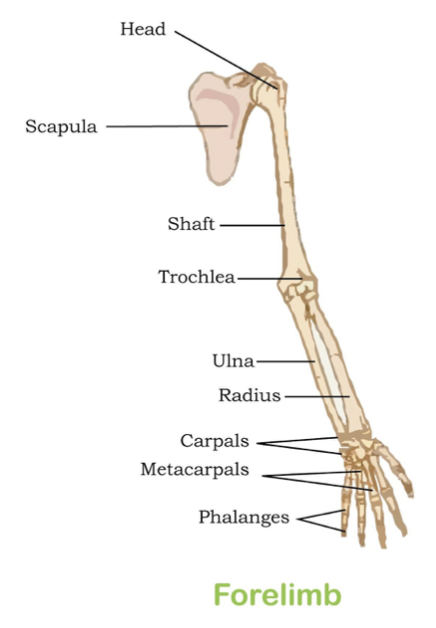
Which one among the following is a bone of the forelimb?
(a) Humerus
(b) Femur
(c) Tibia
(d) Fibula
Answer
481.2k+ views
Hint: They are the long bone of the arm, articulating with the scapula to make the shoulder and the radius and ulna to make the elbow. In situ, it lies obliquely through the ventral thorax and is more horizontal in enormous species.
Complete answer:
The forelimb comprises the humerus, radius, ulna, carpals, metacarpals, and phalanges. The humerus is a long bone in the arm, which passes from the shoulder to the elbow. It connects the scapula and the two bones of the lower arm, the radius, and the ulna. The humeral upper extremity consists of a rounded head, a narrow neck, and two short processes. The body is cylindrical in its upper region and further prismatic below. The humerus provides an attachment to thirteen muscles which contribute to the movements of the hand and elbow, and therefore the function of the upper limb.
Additional Information: The femur is the only bone present within the human thigh. It’s both the longest and the strongest bone within the physical body, extending from the hip to the knee. The tibia is a large long bone of the lower end, joining the knee and ankle joints.
 The fibula is the long, thin, and side bone of the lower leg. It runs parallel to the tibia, or shin bone, and possesses a huge role in stabilizing the ankle and supporting the muscles of the lower leg. Compared to the tibia, the fibula is about an equivalent length but is considerably thinner.
The fibula is the long, thin, and side bone of the lower leg. It runs parallel to the tibia, or shin bone, and possesses a huge role in stabilizing the ankle and supporting the muscles of the lower leg. Compared to the tibia, the fibula is about an equivalent length but is considerably thinner.
So, the correct answer is ‘(a) Humerus’.
Note: Marine mammals are descending from terrestrial mammals whose forelimbs were heaviness appendages limited for terrestrial locomotion. Inside the transition to an aquatic lifestyle, most marine mammals develop a flipper by encasing the forelimb in soft tissue.
Complete answer:
The forelimb comprises the humerus, radius, ulna, carpals, metacarpals, and phalanges. The humerus is a long bone in the arm, which passes from the shoulder to the elbow. It connects the scapula and the two bones of the lower arm, the radius, and the ulna. The humeral upper extremity consists of a rounded head, a narrow neck, and two short processes. The body is cylindrical in its upper region and further prismatic below. The humerus provides an attachment to thirteen muscles which contribute to the movements of the hand and elbow, and therefore the function of the upper limb.
Additional Information: The femur is the only bone present within the human thigh. It’s both the longest and the strongest bone within the physical body, extending from the hip to the knee. The tibia is a large long bone of the lower end, joining the knee and ankle joints.

So, the correct answer is ‘(a) Humerus’.
Note: Marine mammals are descending from terrestrial mammals whose forelimbs were heaviness appendages limited for terrestrial locomotion. Inside the transition to an aquatic lifestyle, most marine mammals develop a flipper by encasing the forelimb in soft tissue.
Recently Updated Pages
Master Class 11 Economics: Engaging Questions & Answers for Success

Master Class 11 Business Studies: Engaging Questions & Answers for Success

Master Class 11 Accountancy: Engaging Questions & Answers for Success

Master Class 11 English: Engaging Questions & Answers for Success

Master Class 11 Computer Science: Engaging Questions & Answers for Success

Master Class 11 Maths: Engaging Questions & Answers for Success

Trending doubts
State and prove Bernoullis theorem class 11 physics CBSE

1 ton equals to A 100 kg B 1000 kg C 10 kg D 10000 class 11 physics CBSE

State the laws of reflection of light

One Metric ton is equal to kg A 10000 B 1000 C 100 class 11 physics CBSE

1 Quintal is equal to a 110 kg b 10 kg c 100kg d 1000 class 11 physics CBSE

Difference Between Prokaryotic Cells and Eukaryotic Cells




